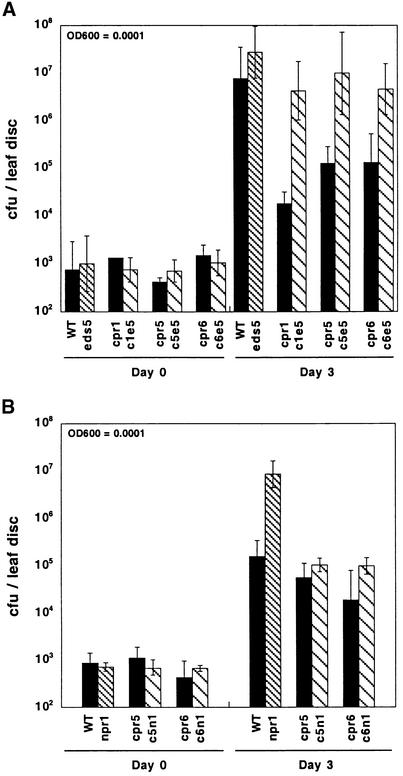Figure 2.
Effects of eds5 and npr1 on the Growth of P. s. maculicola ES4326 in the cpr Mutants.
(A) Growth of P. s. maculicola ES4326 on the cpr eds5 double mutants compared with that on the cpr mutants.
(B) Growth of P. s. maculicola ES4326 on the cpr npr1 double mutants compared with that on the cpr mutants.
Plants were infected by infiltrating a suspension of P. s. maculicola ES4326 in 10 mM MgCl2, corresponding to an OD600 of 0.0001. Leaf discs were collected immediately after infection (day 0) and 3 days later. Four samples from each genotype were collected on day 0; six samples from each genotype were collected on day 3. The cpr1 npr1 double mutant was not tested because of its prohibitively small size. The results obtained in this experiment are different from those reported previously (Bowling et al., 1997; Clarke et al., 1998) because we used 10-fold less bacterial inoculum in the experiments reported here. Although this low bacterial inoculum produced consistent results in distinguishing the resistant mutants from the susceptible ones, the growth of the pathogen varied significantly in wild-type plants. Error bars represent 95% confidence limits of log-transformed data (Sokal and Rohlf, 1981). Growth analysis of P. s. maculicola ES4326 in the cpr eds5 mutants was performed at both Duke and Massachusetts General Hospital with similar results. cfu, colony-forming unit; c1e5, cpr1 eds5; c5e5, cpr5 eds5; c5n1, cpr5 npr1; c6e5, cpr6 eds5; c6n1, cpr6 npr1; WT, wild-type BGL2-GUS transgenic line.

